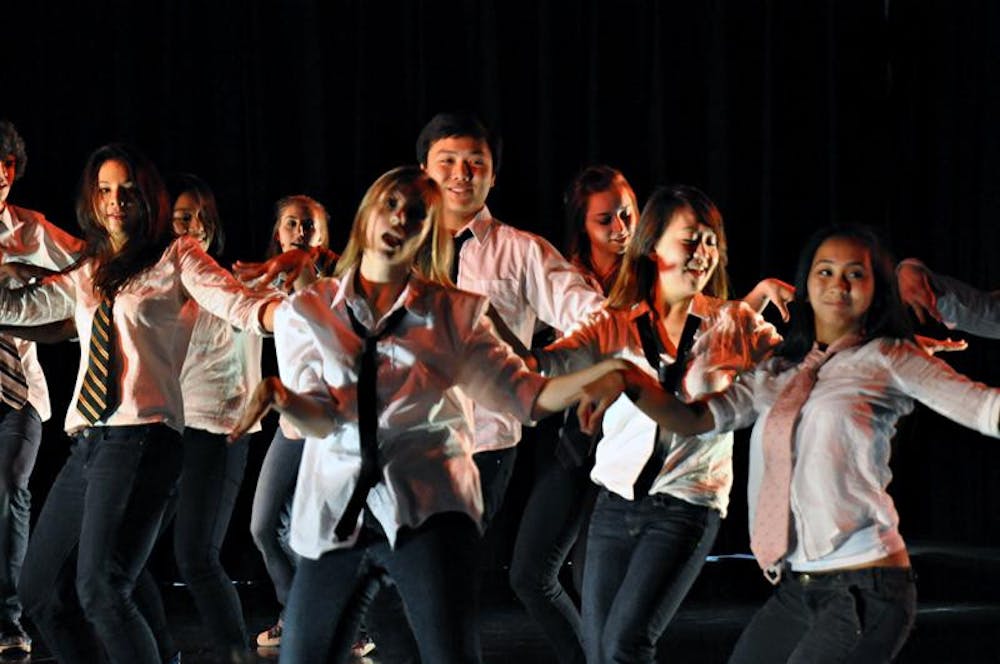As students who tried to purchase tickets may know, the annual Fall Dance Concert sold out — and with good reason. The production did not fall short of expectations, showcasing a diverse and talented group of choreographers and dancers.
The highlight of the show, which was sponsored by the Department of Theater Arts and Performance Studies, was an aerial arts piece titled "Position, Obsession." Set to the eerie sounds of CocoRosie, two performers — Doug McDonald '13 and Andrea Dillon '11.5 — spun and dangled from each other's limbs, climbing and falling over themselves in an effort to beat the other to the top. Their performance told the story of the god Saturn, who "eats his children out of fear that one will dethrone him," according to the program. The emotion the performers conveyed, combined with the difficulty of their art and its visual effect, caused the crowd to gasp and clap several times.
Another high point of the evening was "Dynamique a Quatre," which combined ballet, modern, jazz and hip-hop into a unique style. The music, smooth, jazzy and sexy, went perfectly with the choreography. Cameron Donald's '14 solo embodied the energy, confidence and diversity which made the piece so strong. "Dynamique a Quatre" was also one of the few pieces to use lifts, which added to the variety of the piece.
Traditional dance also had its moment in the spotlight. Members of Badmaash Dance Company performed a Bhangra dance, which originates in India and Pakistan. Dressed in vibrant costumes, the dancers were energetic and engaging. The choreography successfully mixed the traditional aspects of the dance with more current music and moves, prompting a very enthusiastic response from the audience. Badmaash members also performed a piece called "Tut-Adavu," putting a modern twist on the traditional Indian dance Bharatantyam. With techno music and black and silver costumes, the performance had a futuristic feel to it that complemented the traditional style of dancing. The result was visually striking, and the precision and enthusiasm of the dancers made the piece a powerful one.
Contrasting with the traditional ethnic dances were several modern, abstract performances. A piece called "Hyperpnea" explored the way breath influences movement. The heavy beat of the music provided a metronome for the timing of complex, acrobatic movements. A major theme of the piece appeared to mimic electrocution, with dancers writhing and jerking violently on the floor. Though a very impressive and complex piece, it was perhaps too intense for the audience to relate.
On the other hand, "Watch" was a very relatable piece. Before the performance began, video clips of the World Trade Center falling on Sept. 11, 2001, and President John F. Kennedy being shot were screened behind the dance floor. The rest of the piece centered around a small television in one corner of the floor — with slow, dramatic movements, dancers crawled away from the TV, only to eventually make their way back, enthralled by it. The dance effectively captured the emotions of shock and disbelief that come with watching the news on television but also portrayed the chaos of individual reactions. At the end of the piece, the dancers draped themselves over the television, becoming one with it.
"Topical Heat" immediately stood out among the other dances as performers slowly crawled out from under the curtain, mouths gaping as they climbed over one another. With painted faces and quick, jerky movements, the dancers looked like creatures returned from the dead. The complementary music, costumes and choreography gave the piece, which involved mimicking cannibalism, a very clear, animalistic point of view.
"This is the fall venue for student choreography," said Tori Wilson '14, a Body and Sole representative. "This particular show is incredibly important — students as dancers and artists and choreographers can only grow if there's an opportunity."
To participate in the Fall Dance Concert, choreographers must present their piece early in September, Wilson said. They are expected to seek advice from professors and faculty in the meantime and present the improved piece again in October. "Even from the last showing, pieces have grown and changed so much," Wilson said. "It's a very diverse and very cool show."
This year there were "a lot more submissions than we've had in the past," Wilson said, which made the process more competitive. "It was very difficult to make these decisions — everyone clearly worked very hard."
Most participants in the Fall Dance Concert were members of existing dance groups on campus despite her attempt to recruit independent dancers, Wilson said.

ADVERTISEMENT




